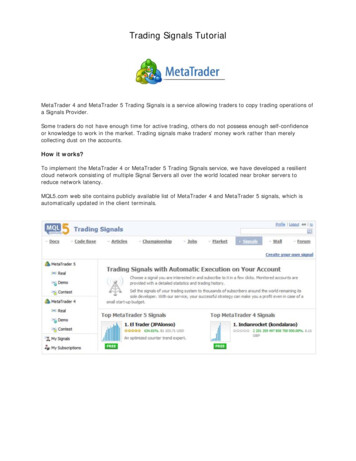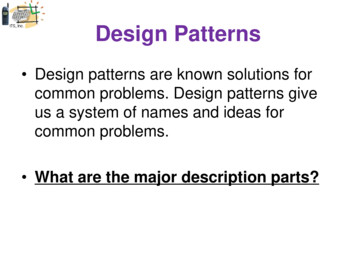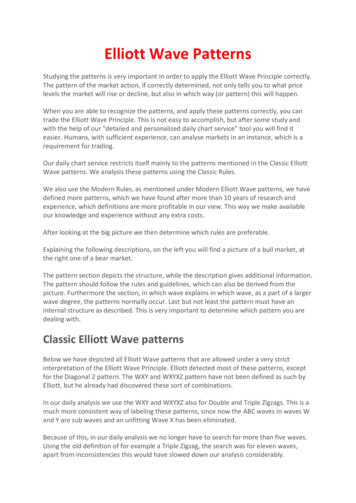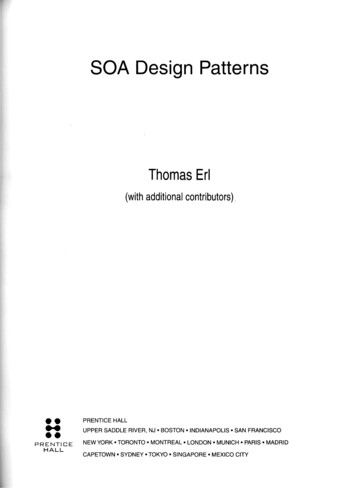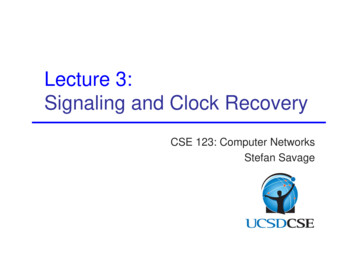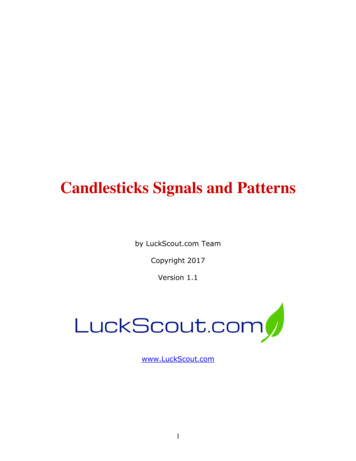
Transcription
Candlesticks Signals and Patternsby LuckScout.com TeamCopyright 2017Version 1.1www.LuckScout.com1
Copyright and DisclaimerCopyright 2017 by LuckScout.com Team. All rights reserved.No part of this publication may be reproduced or transmitted in anyform or by any means, mechanical or electronic, includingphotocopying and recording, or by any information storage andretrieval system, without permission in writing from the author (exceptby a reviewer, who may quote brief passages and/or short brief videoclips in a review).Disclaimer: The authors make no representations or warranties withrespect to the accuracy or completeness of the contents of this workand specially disclaim all warranties, including without limitation,warranties for a particular purpose. No warranty may be created orextended by sales or promotional materials. The advice and strategiescontained herein may not be suitable for every situation. This work issold with the understanding that the authors are not engaged inrendering legal, accounting, or other professional services. Ifprofessional assistance is required, this should be sought fromapplicable parties. The authors shall not be liable for damages arisingherefrom. The fact that an organization or website is referred to in thiswork as a citation and/or a potential source of further information,does not mean that the authors endorse the information theorganization/website may provide or recommendations it may make.Further, readers should be aware that Internet websites listed in thiswork may have changed.2
Table of content:1) Candlestick Signals and Patterns2) High Wave Candlesticks and Their Reversing Power3) How to Trade the Continuation Chart Patterns with Candlesticks andBollinger Bands4) Candlestick, Heikin Ashi and Renko Charts5) The Importance of the Confirmation Candlestick6) Analysis of Strong Piercing Line and Bullish Engulfing CandlestickPatterns7) Features of a Strong Bearish Engulfing Candlestick Pattern8) Dark Cloud Cover and Piercing Line Candlestick Patterns in ForexTrading9) Features of a Strong Dark Cloud Cover Candlestick Pattern10) Hammer and Inverted Hammer Candlesticks11) Hanging Man Candlestick12) Bullish Engulfing and Bearish Engulfing Candlestick Patterns inForex Market13) Abandoned Baby Candlestick Pattern14) Inside Day Candlestick as a Strong Reversal Pattern15) Harami and Harami Cross Candlestick Patterns16) Dragonfly Doji Candlestick: A Frequently Forming Doji17) Daily Candlesticks and Bollinger Middle Band18) What Do the Candlesticks Shadows Tell You?19) Candlestick Patterns and Signals that Make Money20) Gravestone Doji Candlestick: What Does It Mean Exactly?21) Doji Candlestick with Bollinger Bands Are Good Trading Tools3
1) Candlestick Signals and PatternsA typical candlestick has one body and two shadows. The body showsthe open and close prices. In bullish candles, the close price is higherthan the open price. In bearish candles, the close price is lower thanthe open price.To distinguish the bullish and bearish candles from each other, theyare displayed with different colors. Usually, bullish candles are white orgreen, and bearish candles are black or red. In both of the bullish andbearish candles, the upper shadow shows the high price, and the lowershadow shows the low price.That was the anatomy of the typical candlesticks in simple words.However, candlesticks can have several different shapes and patterns.Each shape and pattern has a different signal that tells the traderswhat to do. Candlesticks are great indicators. Many of the professionaltraders use nothing but candlesticks to trade.Doji forms when the open and close prices are virtually equal. A Dojicandlestick looks like a cross, inverted cross or plus sign. Doji meansthat bulls or buyers, and bears or sellers are well matched, and noneof them is stronger than the other one. Therefore, Doji meansindecision. It means after a Doji the trend can be continued, reversedor starts moving sideways. If you have a position, you’d better to closeit and collect your profit when a Doji is formed. Look how many Dojicandles we have on EUR/USD daily chart (watch the video). Many ofthem worked as a reversal signal. The price continued its way aftermany others. The price kept on going up after this Doji. The pricereversed after a few Doji candles formed here (shown in the video).The majority of Japanese candlestick signals are reversals.Hammer and Hanging Man are reversal candlestick signals. They havelong lower shadows and small bodies. Surprisingly, It doesn’t matterwhether these candles are bullish or bearish. When you find one on adowntrend, it is signaling that the trend is near to an end. We call it“Hammer” when formed on a downtrend. A similar candle on anuptrend signals that the uptrend is close to an end. We call it “HangingMan” when formed on an uptrend.4
Although these candles are known as reversal signals, it is better towait for a confirmation when they are formed. It means, when ahanging man is formed on an uptrend, we have to wait for a bearishcandle to form after that, to go short. It is the same with hammer.When formed on a downtrend, we have to wait for a bullish candle toform after that, to go long.Inverted Hammer and Shooting Star are the inverted types of“Hammer” and “Hanging Man”. However, they are weaker signals.They also need confirmation. High-Wave is a Doji candle with longupper and lower shadows. A group of High-Wave candles form astrong reversal signal.The Engulfing Pattern forms by two candles. There are two kinds ofEngulfing Pattern. In Bearish Engulfing Pattern a small candle with abullish body is completely covered by the body of the next candlewhich has a big bearish body. “Bearish Engulfing Pattern” on anuptrend is a strong reversal signal that means the uptrend is endedand will reverse. It is a good chance to go short. In Bullish EngulfingPattern a small candle with a bearish body is completely covered bythe body of the next candle which has a big bullish body. BullishEngulfing Pattern” on a downtrend is a strong reversal signal thatmeans the downtrend is ended and will reverse. It is a good chance togo long.Dark Cloud Cover is a bearish reversal pattern. Like “BearishEngulfing” pattern, it forms with two candles. The second candle opensa little above the close price of the first candle, and goes down andcloses a little above the open price of the first candle.Dark Cloud Cover forms on uptrends and is a strong reversal pattern.Piercing Line is the bullish form of “Dark Cloud Cover” pattern. It formson downtrends, and is a reversal pattern. The second candle opens alittle below the close price of the first candle, and goes up and closes alittle below the open price of the first candle.Harami is another reversal candlestick pattern that forms by twocandles. There are two kinds of Harami. Bullish Harami forms ondowntrends. And, Bearish Harami forms on uptrends. In Bullish Haramia large candlestick is followed by a smaller candlestick, while the bodyof the smaller candle is located within the vertical range of the largerbody.5
In terms of candlestick colors, the bullish harami is a downtrend ofnegative-colored or black candlesticks, engulfing a small positive orwhite candlestick, giving a sign of a reversal of the downward trend.In Bearish Harami a large candlestick is followed by a smallercandlestick, while the body of the smaller candle is located within thevertical range of the larger body. In terms of candlestick colors, theBearish harami is an uptrend of positive-colored or white candlesticks,engulfing a small negative or black candlestick, giving a sign of areversal of the upward trend.The Harami is not a reliable reversal pattern, but it is a useful warning.When a Harami forms while you are already in a position, you shouldmove your stop lossto a proper position, not to lose your profit if the trend reverses.“Harami” means pregnant. The reason is that the first candle with thesecond one, which is smaller, look like a pregnant woman. The smallerthe second candle, the stronger the “Harami” signal is. When thesecond candle is a Doji, the pattern is called “Harami Cross“, which isstronger than the regular Harami.Morning Star is a three candle pattern. This pattern forms ondowntrends. The first candle should be a Bearish candle with aconsiderable body. The second candle is a small candle that is formedlower than the first one. This candle can be Bearish or Bullish. Thethird candle is a Bullish candle that is formed higher than the secondone, and its body covers a significant portion of the first candle.“Morning Star” is called Evening Star when formed on an uptrend.The effectiveness and potency of the Morning Star and Evening Startpatterns as reversal signals is dependent on some special factors thathave to be considered. The distance (gap) between the morning orevening star with the first and third candlesticks. The bigger gap, thestronger signal. The degree of the coverage of the first candlestick bythe third one is also important. The bigger the coverage, the strongerthe signal. Sometimes, the Morning or Evening Star is a Dojicandlestick. Again in this case, the most important thing is the gapbetween the first and third candlestick and the Doji.6
Sometimes, the Morning or Evening Star is a very small candlestickwith small or no shadows. The gap is so big and even none of thecandlesticks shadows cover anypart of the Morning or Evening Star. This pattern is called AbandonedBaby which is a very strong reversal signal. Because of the highvolatility, this pattern is very rare in the forex market and can only beseen in bigger time frames, but it can be seen in the stock market insmaller time frames like one hour. Abandoned baby can be seen bothat the top of an uptrend or bottom of a downtrend.Tweezers is made up of two candlesticks that are next or so close toeach other. They have identical highs at the top of the market oridentical lows at the bottom of the market. The Tweezers usuallybecomes formed by the candlesticks shadows but it can also be madeby the bodies of the shaven candlesticks. The two candlesticks thatform Tweezers can have small bodies like Doji and Hammercandlesticks.Tweezers can not be considered as a strong reversal signals and itneeds confirmation but you have to be careful when you see aTweezers signal. The longer the shadows, the more weight we shouldgive the Tweezers.Tweezers that are formed right under resistance lines or above thesupport lines, are important, specially when they are made up of twoDoji candlesticks. The longer the shadows, the more potent theTweezers signal. It is also possible that you see a few or even severalcandlesticks between the two candlesticks that form the Tweezerspattern. Even in this case you should not ignore the Tweezers as apotential reversal signal.When there are several candlesticks between the two that make theTweezers pattern, they may form Double Tops or Double Bottomspatterns that show the levels of resistance or support.How to Trade the Candlestick Signals and Patterns?First, you have to wait for the candlestick signals and patterns to formcompletely. Then you take the proper position and set the stop loss. Itis strongly recommended to wait for the confirmation candle to form.With the candlestick signals that need confirmation, you take theposition after the confirmation candle. In case of long positions, the7
stop loss has to be below the open price of the confirmation candle. Incase of short positions, the stop loss has to be set above the openprice of the confirmation candle.Click Here to watch the video carefully.8
2) High Wave Candlesticks and TheirReversing Power"High Wave" is a candlestick with a small body and long shadows.However, "High Wave" is known as a candlestick pattern by sometraders. They say "High Wave" is a group of consecutive candlestickswith small bodies and long upper/lower shadows. I like to know "HighWave" as a candlestick pattern, because it is more applicable inpractical trading. Therefore, in this post I consider high wave as apattern, not as a single candlestick.We traders like to have something that shows us the best entry point.It is not only that. We like to know where the best place is to set thestop loss, and also where the best place is to collect the profit and exitthe market.Candlestick patterns are great to show us the entry, SL and exit points.They are on time and reliable, if we wait for the strong ones to form."High Wave" is a very strong reversal pattern. It tells us that sooner orlater the market will reverse, and we can take the advantage of astrong movement. "High Wave" also helps us set a reasonable stoploss which is usually tight enough to let us have a x3 or even x5 target.Therefore, "High Wave" is a nice reversal pattern for trading. It is alsogood to know that they are so frequent in the forex market.Let's analyze one of the markets and see how "High Wave" showed themarket reversal in two occasions.On the GBP/CAD daily chart there are two sets of "High Wave" candles.They formed when the market started ranging while it was stronglygoing up before. In both cases, they clearly indicated that the marketwould reverse, and it really did. When the first set formed, the marketwas going down, but suddenly it changed the direction and went up forover 550 pips. When the second set started forming, the market wasgoing up for several candles, but suddenly changed the direction and abig and long bearish candle formed. In fact the second set is a newlyformed signal.9
Now the question is when is it the best time to enter when a high waveis formed?There are a few ways to enter when a high wave is formed. One waywhich is a little riskier is that you enter when a few high wave candlesform consecutively. You set your stop loss a little below the high wavecandles low price if you go long and visa versa. This is a riskier way,because you enter when the confirmation candle still is not formed. Forexample, if you wanted to trade the above two high waves with thismethod, it would be like this:For the first set, the entry would be at the close of the 2014.02.10or 2014.02.11 candle on the daily chart. For the second set, the entrylevel would be at the close of the 2014.06.19 candle on the daily chart:10
The other way which is a little harder, but less risky is that when ahigh wave forms on a time frame, you switch to a shorter time frame,locate a support (when you are waiting to go short) or resistance(when you are waiting to go long) and wait for its breakout. This givesmore credit to the high wave pattern and when the support orresistance is broken you can take your position with more peace ofmind. Besides, your stop loss can be more reasonable and tighter andyour target can be wider. This method is much harder because youhave to monitor the market for a longer time, and it is possible thatyou miss the chance to enter. I prefer the first method. It is riskier,but we can lower the risk by taking a smaller position.There is another way too. When a high wave forms at the bottom of abear market, you set a buy stop order few pips above the high price ofthe high wave candles. Therefore, when the market reverses andstarts going up, you will have a long position if the price breaks abovethe high price of the high wave candles.It is the same when a high wave forms at the top of a bull market. Youshould set a "sell stop" below the low price of the high wave candles.11
There are a few more things that you have to know about the highwave pattern:1. The longer the shadows and the smaller the bodies of the high wavecandles, the stronger and more reliable the reversal power.2. The number of high wave candles to form a high wave reversalpattern should be at least three. Usually after 3-6 candles the marketwill reverse.Why High Wave Is a Reversal Pattern?"High Wave" forms when the market has been going up or down for awhile. This "while" can be a few to several candles. Usually after goingup or down for a while, the market goes to an "indecision situation",because - for example - when the market is bullish, many of the bullsstop buying and many of them start closing their positions andcollecting their profit. They ask themselves whether the market willkeep on following the same direction or it will reverse. This meansindecision, and it is while the Doji candles that have small or no bodyand long shadows will form. A few of these candles means creates fearof losing of the profit. And it is the time that most of the positionholders close their positions to collect their profit. And so, the marketwill reverse. That is why they say the candlesticks reflect thepsychological situation of the markets.Now, try to locate some high wave candles/patterns on differentmarkets and explain why they caused the markets to reverse. Whatwould you do it you were to trade the high wave patterns you locate?When would you set your stop loss and target orders?12
3) How to Trade the Continuation ChartPatterns with Candlesticks and BollingerBandsI am going to talk about the continuation chart patterns and the waythey can be confirmed by two other strong tools, candlesticks andBollinger Bands. I want to clarify this because some traders say thatonly the line chart is enough to locate and trade the chart patterns. Iam not saying they are wrong, but we can trade the chart patternsmuch better using the candlesticks and Bollinger Bands.Fortunately, some of the currency pairs are trending strongly, andsome new trends are forming with some of the other currency pairs."Trends" create good opportunities to trade the continuation chartpatterns. We should always take the advantage of trends, because it iswhen we can make great profits easier and faster and with less risk.Here I am showing you some of the positions I took recently. EURAUDis one of the pairs which is trending strongly now:13
Recently I took two short positions through following the continuationpatterns formed on the EURAUD chart. While EUR/AUD was goingdown strongly, it reversed after touching the Bollinger Lower Band onMay 13, 14, 15. However, Bollinger Middle Band worked as a strongresistance and did not allow the price to go higher (follow the redarrows). Finally, the 2014.06.05 candle (#1 on the below chart), wentdown and touched the Bollinger Lower band, but closed above thesmall support line that was already formed on the chart. Thismovement, and then the next candle (#2) that also tested the supportline, proved that the support was valid and the consolidation that wasabove the support line was also a valid consolidation.What we have above the first support is a continuation chart patternwhich has formed on a bear market. Now all we need is a supportbreakout. If one of the candles closes below the continuation patternsupport line, we can go short. That is not all. When we have adowntrend, then the Bollinger Lower Band is a great indicator. When acandle touches the lower band after a long time that the other candleshad been closing above it, that is also a great signal that thedowntrend wants to be continued again.14
Candlestick #3 is such a candle. It not only closed below the supportline, but was the first candle among the several last candles thattouched the lower band. I went short at the close of this candle andwhile the next candle was forming, put the stop loss at the middle ofits body (a 30 pips stop loss) and a 150 pips target.The second trade setup:After the 2014.06.12 candle close, EURAUD went against the trend toform another consolidation or continuation pattern. It went up anddown several times and formed some small lows that enabled us toplot the second support line on the chart. Please note that during thetime that EURAUD was going up and down to form the continuationpattern, it never touched the Bollinger Lower Band, which meant thatit was not the time to go short yet. Finally, the candle 2014.07.17which is #3 on the below chart, barely touched the lower band, butclosed above the support line. This could awaken us to get ready to goshort, because it was the first time after such a long time that theprice touched the lower band. It meant that the downtrend wanted tobe continued again.The next candle (#4) formed the trade setup we were waiting for.Exactly like the first trade setup, it closed below the support line andtouched the lower band. I went short while the candle #5 was forming,set the stop loss a little above the broken support line (a 30 pips stoploss), and a 150 pips target that was easily triggered:15
So when we have a downtrend and then a continuation pattern forms,we have to.1. Wait for the pattern to form a support line.2. Wait for a candle to close below the support line.3. If the candle that closes below the support line also touches thelower band, we will have a perfect trade setup.It is the same with the uptrends. When there is an uptrend, we haveto wait for a continuation pattern and its resistance. When one of thecandles closes above the resistance and touches the Bollinger UpperBand, then we will have a perfect trade setup to go long.For both of these setups, first we need a strong trend already formed,otherwise the support or resistance breakout and the candle thattouches the lower or upper band means almost nothing.16
4) Candlestick, Heikin Ashi and RenkoChartsPrice chart is the best tool to follow the markets movements, and upsand downs. The price movement in long term, can not only teach us alot of things, but also it can help us decide whether to enter themarket or wait for a better chance.Monitoring the markets' price movements during the past centuries,has made the traders alter the simple line charts, and create someother kinds of charts that are a lot more useful and effective inanalysing the traders sentiments, and predicting the futuremovements.It seems what Japanese traders have done, is way above the others.Japanese Candlesticks is the most famous invention of the Japanesetraders. It is the most important tool we use here on LuckScout.Combination of Japanese Candlesticks with Bollinger Bands hascreated a great trading system for us that has enabled us to locate thestrongest reversal and continuation trade setups, in bull, bear and flatmarkets.Regular candlesticks are not the only invention of Japanese traders.They have at least two more inventions similar to candlesticks.Renko is one of the other inventions of Japanese traders. In regularcandlesticks, time has a very important role, but in Renko chart onlythe price changes are recorded. It is a good tool for those who want totrade based on the price actions only. Renko can eliminate a lot ofnoise and shows only the strong movements and trends. It is a goodtool for trend and swing traders.Heikin Ashi is one of the other Japanese traders' inventions. It ispronounced Heikin AasAahee.Heikin Ashi looks like the regular candlesticks at the first glance, but itis very different in reality. There are some very important differencesbetween the regular candlesticks and Heikin Ashi. There are twomoving averages built in the Heikin Ashi candlesticks. In regularcandlesticks, each candlestick is completely independent, and has norelation with the previous and next candlestick, but in Heikin Ashicandles are related to each other, because the open price in each17
Heikin Ashi candle is the average of the open and close prices of theprevious candle. This is the most important difference.The other difference is that the close price in each Heikin Ashi candle isthe average of open, close, high and low prices during each unit of thetime frame. For example if you use Heikin Ashi on the daily time frame,then the close price of each Heikin Ashi candle is the average of theopen, close, high, and low prices in 24 hours.The Heikin Ashi candle's high and low prices are also different. Thehigh price is chosen from the highest price among the high, open andclose prices during each unit of the time frame. Similarly, the low priceis chosen from the lowest price among the high, open and close pricesduring each unit of the time frame.As you see all of the four prices are completely different in Heikin Ashi.Why is that? Why did the Japanese traders made these changes in theregular candlesticks to have a candlestick named Heikin Ashi?It was because of eliminating the noise again, like what Renkodoes. Japanese traders believe that in order to become able to tradeproperly, we should eliminate the price noises and only have thestrong and real price moments. They believe that it is the noise thatcauses traders to make mistakes. If you look at a Heikin Ashi chart,you will see that bearish and bullish candlesticks are not too mixedwith each other. When there is an uptrend, most of the candles arebullish and you can rarely see a bearish candle among them. It is thesame when there is a downtrend. However, with the regularcandlesticks you see several bearish candlesticks among thebullish ones, when there is an uptrend, and visa versa for downtrends.The reason is that in Heikin Ashi most of the noise is eliminatedbecause of the averaging system that is used to calculate the open andclose prices.Heikin Ashi is great for the swing traders who love to follow the trends.It works very well when the market trends. However, it becomes hardto trade the ranging and sideways markets with Heikin Ashi, comparedto regular candlesticks, specially when the range becomes tighter.There is an old article on LuckScout about Heikin Ashi. If you like tolearn more about Heikin Ashi candles, and the way they can be used intrading, please read that article: What Is Heikin Ashi and How ToTrade With It18
Also there is an article about Heikin Ashi installation onMT4: Download Heikin Ashi and Smoothed Heikin Ashi Indicator andTemplate for MetaTraderWhich One Do I Recommend?I am a regular candlestick fan, because each candlestick talks clearlyabout the market's condition. It can look noisy compared to Renkoand Heikin Ashi charts, but those ups and downs are not noise forthose who know the language of the candlesticks. They just clearlyexplain what is going on with the markets. Maybe it takes more timefor a novice trader to learn to work with regular candlesticks,compared to Renko and Heikin Ashi, but it is worth the time you spend,because you will become able to (1) pick better trade setups, and (2)have better entry and exits prices. This makes a big difference.19
5) The Importance of the ConfirmationCandlestickThere are two kinds of candlestick signals from my point of view andaccording to my experiences:1. The signals that have to be confirmed by the next candlestick2. The signals that are strong enough the way that the don't toneed to be confirmed by the next candlestick.It is important to know the difference of these kinds of candlesticks,because with the first group, first you have to wait for the confirmationcandlestick to form to complete the signal and trade setup. If youdon't wait for the confirmation candlestick, it is highly possible thatyou lose.With the second group you can take a position without having to waitfor the next candlestick to form as the confirmation. If you wait for thenext candlestick, you will miss a big movement and it will become toolate to enter.Sometimes the market starts moving strongly for several candlesticks.These candlesticks have strong bodies and small shadows that reflectthe power of the movement. However, after a few to few candlesticks,the market slows down and you will see the candlesticks that havesmall bodies and long upper and lower shadows. Some of them evenhave no body at all. These candlesticks are called Doji.Doji candlesticks reflect the market indecision. It means the marketdoesn't know whether it can keep on following the same direction, or itis time to stop and reverse.When most traders buy, the market goes up strongly. And then, whenmany of them think that it is time to sell and collect their profit, themarket stops going up as strong as it was used to. The body ofcandlesticks become smaller. In spite of this, some traders still thinkthat the market will keep on going up, and so they buy. But the pricegoes up and down, and it is the time that Doji candlesticks startforming.When some traders sell and some others buy, the market goes toindecision, and it doesn't know where to go. When most traders buy,the price goes up and we will have bullish candlesticks with strong20
bodies forming on the chart. When most traders sell, the price goesdown and we will have bearish candlesticks with strong bodies. Whensome of them sell and some of them buy (indecision), Dojicandlesticks will form on the price chart.Now the question is what will happen when the Doji candlesticksappear on the chart? Will the price keep on following the samedirection again, or it will reverse?Forming just one single Doji that has no long shadows, doesn't meanthat the market will reverse, unless a confirmation candlestick withstrong body forms after the Doji, or even a few to few candlesticksafter. For example, when the price is going up and a Doji forms, andthen a strong bearish candlestick forms after the Doji, most probablythe market will reverse and will go down at least for a few morecandlesticks. In this case, we can take the advantage of BollingerBands. If the Doji and preferably the confirmation candlestick show astrong breakout on the Bollinger Upper Band, then the reversal ismore probable.To learn more about this, please read this article: How to Trade UsingDoji Candlestick and Bollinger Bands Here, I am showing you an example. As the below chart shows,EUR/USD has been going up for several candlesticks, buton 2012.09.17 a Doji candlestick forms. When the Doji is closed, stillnobody knew whether EUR/USD would keep on going up, or it wouldreverse. However, the next candlestick (2012.09.18) which is bearishwith a relatively strong body "confirmed"
Feb 11, 2014 · 1) Candlestick Signals and Patterns 2) High Wave Candlesticks and Their Reversing Power 3) How to Trade the Continuation Chart Patterns with Candlesticks and Bollinger Bands 4) Candlestick, Heikin Ashi and Renko Charts 5) The Importance of the Confirmation Candlestick 6)


